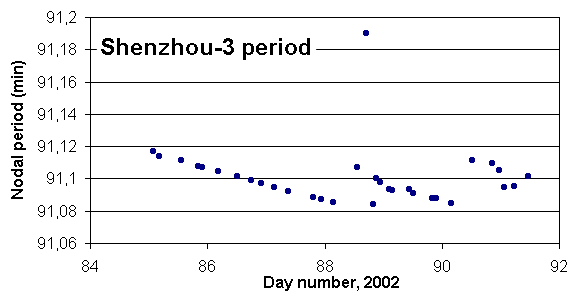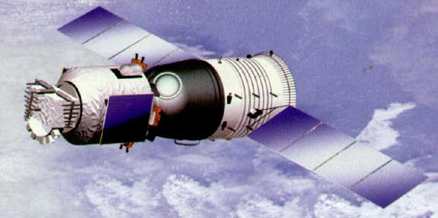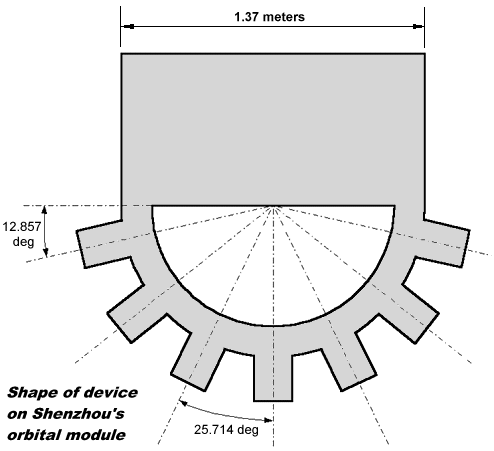Shenzhou-3 notes
Sven Grahn
Here I will collect notes on
the flight of Shenzhou-3.
Tabular comparion between
Shenzhou test flights
| Spacecraft |
Launch date |
Launch time |
Initial orbit |
Operational orbit |
Incl. |
Time to landing |
Landing time |
| Shenzhou-1 |
19 Nov. 1999 |
2230 UT |
196-324 km |
No maneuvers |
42,59 |
0.883 days, 14 revs |
20 Nov. 1999, 1941 UT, 0241 LT |
| Shenzhou-2 |
9 Jan. 2001 |
1700 UT |
196-334 km |
329-339 km |
42.58 |
6.765 days, 107 revs |
16 January 2001, 1122 UT, 1822
LT |
| Shenzhou-3 |
25 Mar. 2002 |
1415 UT |
194-313 km |
331-337 km |
42.40 |
6.775 days, 107 revs |
1 April 2002, 0851 UT, 1551 LT |
It is interesting to note
the large spread in landing times. The local time at landing have been calculated
using the assumption that the landing occurs in the UT + 7 h time zone (ignoring
the fact that all of China is UT + 8 h). So, all but the last landing occurred
in darkness. One wonders why?
It is also noteworthy that
the inclination of the third flight is slightly different from that of the
first two flights.
Technical details about Shenzhou
The following general details
have been obtained from China Space News as recounted
at the SpaceDaily website.
| Overall mass |
7800 kg |
| Orbital module |
2.8 m long, 2.25 m diameter,
12 m2 solar array |
| Descent module |
2.059 m long, 2.5 m base
diameter |
| Propulsion Module |
2.94 m long, 2.8 m max
diameter, 24 m2
solar array. |
Orbital period and maneuvers
 The graph on the right shows
the nodal period for Shenzhou-3 as derived from Two-Line Element sets. Clearly
there were at least two major manoeuvres after the initial manoeuvre to the
91-min period. However, US Space Command did not publish the initial orbit
of Shenzhou-3, but it can be inferred from that of the rocket body left in
the initial orbit. The manoeuvres following the initial orbital manoeuvre
occurred on 29 March and on 31 March, i.e. the day before recovery.
The graph on the right shows
the nodal period for Shenzhou-3 as derived from Two-Line Element sets. Clearly
there were at least two major manoeuvres after the initial manoeuvre to the
91-min period. However, US Space Command did not publish the initial orbit
of Shenzhou-3, but it can be inferred from that of the rocket body left in
the initial orbit. The manoeuvres following the initial orbital manoeuvre
occurred on 29 March and on 31 March, i.e. the day before recovery.
The orbital period as shown
in the graph was kept just below the period for a 31-revolution repeating
pattern (91.126 min). This is quite similar to that of Shenzhou-2 after its
initial manoeuvre from its injection orbit.
It is not immediately possible
to ascertain of the orbital elements corresponding to the data point at 91.19
minutes in the graph are real or just an artefact caused by noisy radar data.
The same is true for the data point immediately following this "outlier".
A possible ELINT payload
on Shenzhou?
 The day after launch Chinese
media published a fascinating artist's view of Shenzhou in orbit (right).
It showed what looks very much like three seven element log-periodic antennas
mounted at the front of the orbital module. In the picture the antennas point
towards the earth and they probably do so in flight also. The antennas seem
to be linearly polarized. One of the three antennas has its polarization
plane orthogonal to that of the two others. Therefore, it seems that
maybe the two co-polarised antennas work as an interferometer, while the
orthogonal antenna could perhaps be used to determine the polarization of
the incoming wave. The gain of a log-periodic is often relatively modest,
say 5-10 dBi. The longest element corresponds to the lowest operating frequency
of the antenna and the shortest element length corresponds to the highest
operating frequency. in This case the longest element is about 0.5 meters
long and the shortest is 0.15 meters long. That means that the antenna array
seems to be designed for a frequency range around 300-1000 MHz. The artist's
conception does not permit any more detailed analysis of the antenna.
The day after launch Chinese
media published a fascinating artist's view of Shenzhou in orbit (right).
It showed what looks very much like three seven element log-periodic antennas
mounted at the front of the orbital module. In the picture the antennas point
towards the earth and they probably do so in flight also. The antennas seem
to be linearly polarized. One of the three antennas has its polarization
plane orthogonal to that of the two others. Therefore, it seems that
maybe the two co-polarised antennas work as an interferometer, while the
orthogonal antenna could perhaps be used to determine the polarization of
the incoming wave. The gain of a log-periodic is often relatively modest,
say 5-10 dBi. The longest element corresponds to the lowest operating frequency
of the antenna and the shortest element length corresponds to the highest
operating frequency. in This case the longest element is about 0.5 meters
long and the shortest is 0.15 meters long. That means that the antenna array
seems to be designed for a frequency range around 300-1000 MHz. The artist's
conception does not permit any more detailed analysis of the antenna.
Walter Ridgewell
wrote: "I have some captured images from CCTV via satellite. On the
news program the day after launch, they showed an animation on the orbital
module after separation. The animation showed the three 'booms' on the front
of the module extending, one left, one right and one forward. For point of
reference the booms extended beyond the length of the solar panels on the
orbital module." This strengthens the impression that the three log-periodic
antennas form some kind of direction-finding array.
The revelation of these Yagi
antennas naturally prompts speculation as to what the crescent of seven "boxes"
on the earth-facing side of the box at the front of the orbital module is.
Could they perhaps be an array of waveguide horns for detecting (and locating)
radar transmissions on the earth? The outermost "boxes" pint about 12 degrees
below the local horizontal. The Earth's edge ("horizon") is about 18 degrees
below the local horizontal plane at the orbital altitude of Shenzhou.
The geometry of the seven
"boxes" and the "crescent" is shown below.


 Back
to Space History Notes
Back
to Space History Notes
 The graph on the right shows
the nodal period for Shenzhou-3 as derived from Two-Line Element sets. Clearly
there were at least two major manoeuvres after the initial manoeuvre to the
91-min period. However, US Space Command did not publish the initial orbit
of Shenzhou-3, but it can be inferred from that of the rocket body left in
the initial orbit. The manoeuvres following the initial orbital manoeuvre
occurred on 29 March and on 31 March, i.e. the day before recovery.
The graph on the right shows
the nodal period for Shenzhou-3 as derived from Two-Line Element sets. Clearly
there were at least two major manoeuvres after the initial manoeuvre to the
91-min period. However, US Space Command did not publish the initial orbit
of Shenzhou-3, but it can be inferred from that of the rocket body left in
the initial orbit. The manoeuvres following the initial orbital manoeuvre
occurred on 29 March and on 31 March, i.e. the day before recovery.
 The day after launch Chinese
media published a fascinating artist's view of Shenzhou in orbit (right).
It showed what looks very much like three seven element log-periodic antennas
mounted at the front of the orbital module. In the picture the antennas point
towards the earth and they probably do so in flight also. The antennas seem
to be linearly polarized. One of the three antennas has its polarization
plane orthogonal to that of the two others. Therefore, it seems that
maybe the two co-polarised antennas work as an interferometer, while the
orthogonal antenna could perhaps be used to determine the polarization of
the incoming wave. The gain of a log-periodic is often relatively modest,
say 5-10 dBi. The longest element corresponds to the lowest operating frequency
of the antenna and the shortest element length corresponds to the highest
operating frequency. in This case the longest element is about 0.5 meters
long and the shortest is 0.15 meters long. That means that the antenna array
seems to be designed for a frequency range around 300-1000 MHz. The artist's
conception does not permit any more detailed analysis of the antenna.
The day after launch Chinese
media published a fascinating artist's view of Shenzhou in orbit (right).
It showed what looks very much like three seven element log-periodic antennas
mounted at the front of the orbital module. In the picture the antennas point
towards the earth and they probably do so in flight also. The antennas seem
to be linearly polarized. One of the three antennas has its polarization
plane orthogonal to that of the two others. Therefore, it seems that
maybe the two co-polarised antennas work as an interferometer, while the
orthogonal antenna could perhaps be used to determine the polarization of
the incoming wave. The gain of a log-periodic is often relatively modest,
say 5-10 dBi. The longest element corresponds to the lowest operating frequency
of the antenna and the shortest element length corresponds to the highest
operating frequency. in This case the longest element is about 0.5 meters
long and the shortest is 0.15 meters long. That means that the antenna array
seems to be designed for a frequency range around 300-1000 MHz. The artist's
conception does not permit any more detailed analysis of the antenna.